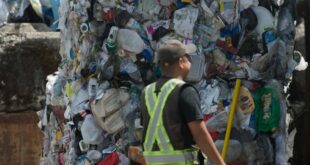Popular reusable cups may be 'built for life' but environment advocates warn of lasting waste when fad fades

A gigantic tumbler that purportedly keeps drinks cold even if it's left in your burning car is the stainless steel status symbol of the moment.
The 40 oz. Stanley Quencher H2.0 Flowstate tumbler (that's 1.18 litres for us metric system folks) has become so popular that people are willing to wait outside Target stores overnight for the latest limited edition colours, cosmo pink and Target red for Valentine's Day, while TikTok influencers can rack up huge view counts with their cup content.
And, yes, one Stanley tumbler stan not only claimed hers survived a car fire, in post that went viral, the company's president sent her a personal message with a promise to send her a new collection of cups — and a brand new vehicle.
This is the kind of hype many businesses would dream of and it's helped Stanley increase its annual profits 10-fold in the past four years as a result, CNBC reported last month.
But even if the cups themselves are built to last — an eco-friendly alternative, perhaps, to single-use cups and bottles — the very notion of a trendy water bottle gets in the way of sustainability, say advocates.
Consumer trends come and go. Sustainability experts warn many of today's hot tumblers will eventually end up in a landfill just like their paper and plastic counterparts once this fad is over.
"The planet is on fire and all of our consumer habits definitely play a part in it," said Aja Barber, a U.K.-based author who writes about how our buying habits affect us and the rest of the world.

The Stanley Cup is one of the newest trends…no, not the hockey trophy – the Stanley-brand line of stainless steel travel mugs and cups. They're so popular, some people are even willing to fight for them in stores. But what makes these thermal mugs such a hot item? CBC’s Amy Feehan hit the streets of Corner Brook to ask people.
From trend to trash
Reusable beverage containers like the Stanley tumblers may be better than the disposable options in many ways, but Barber said you only need to own one or two of them.
"That's not what's happening with the Stanley cup phenomenon. People are becoming collectors and seeking them out," she said, referencing videos on TikTok showing people lining up dozens of their Stanleys, as they're commonly called.
Barber mentioned many of the people buying the tumblers likely had perfectly good reusable drink containers in their cupboards already — something social media critics of the craze have mocked.
Before the Stanley, other insulated and pricey metal bottles had their moment: the S'well, the Yeti, and the giant Hydroflask, among others.
Stanley, which has been manufacturing insulated drink flasks, cups and bottles for more than 110 years, bills its products as "built for life."
But Barber is skeptical many of the Stanley tumblers will remain in use that long.
Her concern is that there aren't many options, other than the trash can, to dispose of the tumblers when people tire of them and move on to the next popular product, as has happened with other trendy water bottles and travel cups in the past.
You can't just drop these products in your blue bin with other common recyclables, like empty pop cans and pickle jars, and Barber said your used drink ware isn't likely to be as popular on a thrift store shelf.
"The majority of our society will not want to buy a second hand Stanley cup. I think we can be honest with ourselves about that."
Built to last but with a lasting impact
Stanley, and its Seattle-based parent company PMI Worldwide, may promote sustainability practices, but Barber cautions about taking corporate social responsibility statements with a grain of salt.
CBC News attempted to contact PMI Worldwide but was unable to reach anyone with the company.
According to its most recent corporate social responsibility report, the company claims to use 90 per cent recycled stainless steel in the Quencher H2.0 Flowstate tumbler and similar products.
That doesn't create a "closed loop" when it comes to the environmental impact of all of those cups, said Myra Hird, a professor in the environmental studies department at Queen's University in Kingston, Ont.
She told CBC News any reusable metal or plastic container is made from materials that involve resource extraction and that are "bad for the environment" — even if they're recycled.
"Recycling creates waste and it often creates toxic waste that is more difficult to dispose of than the original product."
On top of that, she said, the steel in the cups probably can't be recycled by the consumers because it's likely coated with a type of plastic film on the inside, for that signature long-lasting insulation, and it's covered with a polymer-based powder coat finish on the outside.
Separating those materials from the metal is not only near-impossible, she said, it's not cost-effective to do.
Despite the company's claim to manufacture Quencher H2.0 Flowstate tumblers with mostly recycled metal, Stanley doesn't appear to offer any sort of take back program or end-of-life recycling options for its own products.
That's something Hird believes we need to change, in general.
She said there are efforts to promote what are known as extended producer responsibility policies in Canada that would put the onus on companies to have physical and/or financial responsibility to manage the products they manufacture at their consumer life cycle.
Rethinking hyper-consumerism
Hird and Barber both have their own reusable beverage containers — no Stanley tumblers, though — and see the value in owning one, but they don't support this type of trend-driven hyper-consumerism and say it's something we need to reduce.
"We have to stop letting, you know, consumer trends just overtake our common sense," said Barber, acknowledging many of us are susceptible to the pressures of social media and marketing.
Hird pointed out there was a time, not too long ago, when nobody walked around with giant beverage containers and most people used public water fountains when they needed a quick drink, which she said is actually more environmentally-friendly than any reusable cup or bottle.
Ultimately, she said, to avoid any negative environmental impact from your Stanley tumblers, you would have to keep reusing them for the rest of your life and then pass them on to your children.
ABOUT THE AUTHOR
Senior Writer
Nick Logan is a senior writer with CBCNews.ca based in Vancouver. He has worked as a multi-platform reporter and producer for more than a decade, with a particular focus on international news. You can reach out to him at nick.logan@cbc.ca.
*****
Credit belongs to : www.cbc.ca
 MaharlikaNews | Canada Leading Online Filipino Newspaper Portal The No. 1 most engaged information website for Filipino – Canadian in Canada. MaharlikaNews.com received almost a quarter a million visitors in 2020.
MaharlikaNews | Canada Leading Online Filipino Newspaper Portal The No. 1 most engaged information website for Filipino – Canadian in Canada. MaharlikaNews.com received almost a quarter a million visitors in 2020.







